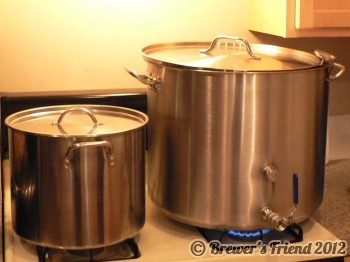Bulkhead for Cooler style Mash / Lauter Tun
Monday, January 12th, 2009If you are converting a cooler into a mash / lauter tun this guide will show you how to install a bulkhead and ball valve. On the outside of the cooler, a ball valve attaches to a bulkhead. The bulkhead passes through the wall of the cooler. On the inside it connects to the manifold or braid so the wort will drain in a uniform fashion, with the flow controlled by the ball valve. Nuts and washers on either side of the bulkhead pipe (called a pipe nipple), compress against the walls of the cooler and form a water tight seal. Be warned, this is a fair bit of work to get done and may require several trips to the hardware store.
The bulkhead looks awesome when it is installed. It is something you can be proud of. The first time you open the ball valve to drain wort it is exhilarating, like that first ever sip of home brew. Your friends will be amazed by your dedication to the art.
The finished product:


The first step is drilling the hole in the cooler. For a 1/2” nipple make a 3/4” hole.

In this design I am not using nuts to tighten down the washers. By choosing a very short nipple, the ball valve and the copper converter act like nuts compressing the washers against the walls of the cooler. I added some silicone sealant underneath the washers and inside the opening before assembling, then wiped away the excess after tightening.

Test assembled:

You will need to improvise based on what is available at the hardware store. The hardware guys will look at you like you are nuts when you try to explain what you are doing. A quick note about metals, I would not use anything but stainless steel, copper, or brass for the bulkhead. Palmer’s book How To Brew, has a lot of great information about using metals in the brewery.
On the end of the ball valve, you can convert to vinyl tubing easily with a barbed hose fitting.
Tools:
Drill
3/4” hole saw, spade bit or forstner bit
Medium size crescent wrench
Channel locks
Materials outline:
Ball valve – accommodating 1/2” pipe, stainless steel or brass
1/2” brass or stainless steel pipe nipple, short as possible for your cooler – usually 1”
2 stainless steel washers
Rubber washer for outside
Pipe thread to copper converter
Silicone sealant
One place you can get the parts online is https://www.mcmaster.com/. They are expensive, but this site has everything under the sun, including stainless steel parts.
There is one alternative to the bulkhead approach if you are using a cooler. Some people siphon wort through an outlet in their manifold. I find siphoning to be a clumsy approach. The wort is HOT (around 165 F) so you don’t want to be handling it. I have also seen plastic valves instead of the copper ball valve which attach to a hose.
This site has a related article on how to build a copper manifold for this cooler.
You are welcome to ask questions by commenting below.












